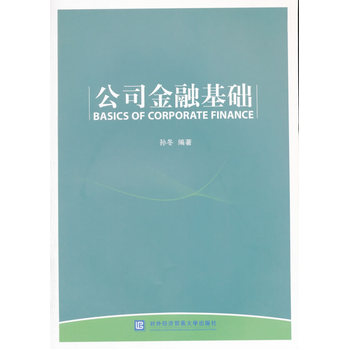简介
本书以价值及价值创造为核心,并以这一核心形成逻辑顺序,系统地阐述了公司金融学的理论和方法,包括与公司金融决策相关的基础财务知识、投资决策和方法、融资方式和融资决策、公司价值评估方法等基本内容。本书主要有以下特色: (1)内容集中、重点突出。本教材集中于公司金融学研究的主要领域和基本议题,如公司金融战略和价值估值、资本预算、融资方式、资本结构、股利政策以及公司金融学的基本研究方法,为学生提供了公司金融学研究的基本线路和框架图。 (2)体系完善、、注重衔接。本教材与其他金融学课程相辅相成,形成完整的金融学知识体系。资本预算部分与项目融资课程相互补充,融资方式与金融工具定价相互补充,资本结构与风险管理课程内容有一定相关,股利分配与投资银行学互为补充。这样有利于学生对金融学的学习形成一个全局观念,同时也避免了各门课程之间内容的重复。 (3)语言简洁、表述平实。本教材介绍和总结了国际和国内公司金融学实证研究中得出的主要结论、发现的一些规律和现象,并且用简要、直观且学生比较容易理解的语言和方法阐述了用于理解这些规律和现象的最主要的理论模型和理论知识。
目录
CHAPTER l Introduction
11 The Form ofBusiness Organization
12 The Goal ofthe Corporate Finance
13 Financial Markets
Questions andProblems
CHAPTER 2 Accounting Statements and Cash Flow
21 The Balance Sheet
22 The Income Statement
23 NctWorking Capital
24 Financial CashFlows
25 The Statement ofCash Flows
26 Financial Reporting in Practice
Questions and Problems
CHAPTER 3 Net Present Value:First Principles of Finance
31 Making Consumption Choices overTime
32 The Basic Principle of Investment Decision Makin9
33 IllustratingtheInvestmentDecision
Questions and Problems
CHAPTER 4 NetPresentValue
41 TheoneperiodCase
42 The Multi—period Case
43 Compounding Periods
44 Simplifications
45 Enterprise Value
Questions and Problems
CHAPTER 5 Some Alternative Investment Rules
51 WhyUseNetPresentValue?
52 The Payback Period Rule
53 TheDiscountedPaybackPeriodRule
54 The Internal Rate ofReturn,
55 The Profitability Index
56 The Practice ofCapital Budgetin9
Questions andProblems
CHAPTER 6 Net Present Value and Capital Budgetin9
61 Incremental CashFlows
62 The Baldwin Company:An Example
63 Inflation andCapitalBudgetin9
64 The EquivalentAnnual CostMethod
Questions and Problems
CHAPTER 7 RiskAnalysis and Project Evaluation
71 Decision Trees
72 Real Options
73 SensitivityAnalysis
74 ScenarioAnalysis
75 Monte Carlo Simulation
76 BreakevenAnalysis
Questions andProblems
CHAPTER 8 Capital Market Theory:An Overview
81 ReturnBasics
82 Return Statistics
83 Risk
84 CapitalMarketTheory
Questions and Problems+++
CHAPTER 9 Corporatefinancing Decisions and Efficient Capital Markets
91 Can Financing Decisions Create Value?
92 ADescription ofE伍cient Capital Markets
93 The Different Types ofEfficiency
94 The Evidence ofEfficient Market Hypothesis
95 Criticism andBehaviorFinance
96 Empirical Challenges to Market Efficiency
97 Implications for Corporate Finance
Questions andProblems
CHAPTER l0 Lon9—term Financin9:An Introduction
101 Common Stock
102 The Basics ofCorporate Lon9—term Debt
103 Preferred Stock
104 Patterns ofFinancin9
105 Recent Trends in Capital Structure
Questions and Problems
CHAPTER ll Capital Structure:Basic Concepts
111 The Capitalstructure Question and the Pie Theory
112 FirmValue versus StockholderInterests
113 Financial Leverage andFirmValue
114 Modigliani and Miller:Proposition I and II(No Taxes)
115 Modigliani and Miller:Proposition I and II(Taxes)
Questions and Problems+J,
CHAPTER l2 Capital Structure:Limits to the Use of Debt
121 Costs ofFinanciaI Distress
122 CanCosts ofDebtBeReduced?
123 0ptimal Capital Structure:The Trade—offTheory
124 TheAgency Benefits ofLeverage++
125 Asymmetric Information and Capital Structure
126 The Peckin9orderTheory
127 Growth andtheDebtequityRati0
128 TheMillerModelwithPersonalTaxes
129 How Firms Establish Capital Structure
Questions andProblems++
CHAPTER l3 Valuation and Capital Budgeting for the Levered Firm
131 Adjusted—present—valueApproach
132 Flows—t0—equityApproach
1 33 Weighted—average—cost—ofcapital Method
134 A Comparison ofthe APVFTEand WACC Approaches
135 Projectbased Costs ofCapital
136 Beta andLeverage
Questions andProblems
CHAPTER l4 Dividend Policy
141 DifferentTypes ofDividends
142 Standard Method ofCash Dividend Payment
143 DividendPolicyandValue ofFirm
144 Repurchase ofStock
145 DividendPolicy inPractice
146 Non—cash Distributions
Questions and Problems
Reference Resources
11 The Form ofBusiness Organization
12 The Goal ofthe Corporate Finance
13 Financial Markets
Questions andProblems
CHAPTER 2 Accounting Statements and Cash Flow
21 The Balance Sheet
22 The Income Statement
23 NctWorking Capital
24 Financial CashFlows
25 The Statement ofCash Flows
26 Financial Reporting in Practice
Questions and Problems
CHAPTER 3 Net Present Value:First Principles of Finance
31 Making Consumption Choices overTime
32 The Basic Principle of Investment Decision Makin9
33 IllustratingtheInvestmentDecision
Questions and Problems
CHAPTER 4 NetPresentValue
41 TheoneperiodCase
42 The Multi—period Case
43 Compounding Periods
44 Simplifications
45 Enterprise Value
Questions and Problems
CHAPTER 5 Some Alternative Investment Rules
51 WhyUseNetPresentValue?
52 The Payback Period Rule
53 TheDiscountedPaybackPeriodRule
54 The Internal Rate ofReturn,
55 The Profitability Index
56 The Practice ofCapital Budgetin9
Questions andProblems
CHAPTER 6 Net Present Value and Capital Budgetin9
61 Incremental CashFlows
62 The Baldwin Company:An Example
63 Inflation andCapitalBudgetin9
64 The EquivalentAnnual CostMethod
Questions and Problems
CHAPTER 7 RiskAnalysis and Project Evaluation
71 Decision Trees
72 Real Options
73 SensitivityAnalysis
74 ScenarioAnalysis
75 Monte Carlo Simulation
76 BreakevenAnalysis
Questions andProblems
CHAPTER 8 Capital Market Theory:An Overview
81 ReturnBasics
82 Return Statistics
83 Risk
84 CapitalMarketTheory
Questions and Problems+++
CHAPTER 9 Corporatefinancing Decisions and Efficient Capital Markets
91 Can Financing Decisions Create Value?
92 ADescription ofE伍cient Capital Markets
93 The Different Types ofEfficiency
94 The Evidence ofEfficient Market Hypothesis
95 Criticism andBehaviorFinance
96 Empirical Challenges to Market Efficiency
97 Implications for Corporate Finance
Questions andProblems
CHAPTER l0 Lon9—term Financin9:An Introduction
101 Common Stock
102 The Basics ofCorporate Lon9—term Debt
103 Preferred Stock
104 Patterns ofFinancin9
105 Recent Trends in Capital Structure
Questions and Problems
CHAPTER ll Capital Structure:Basic Concepts
111 The Capitalstructure Question and the Pie Theory
112 FirmValue versus StockholderInterests
113 Financial Leverage andFirmValue
114 Modigliani and Miller:Proposition I and II(No Taxes)
115 Modigliani and Miller:Proposition I and II(Taxes)
Questions and Problems+J,
CHAPTER l2 Capital Structure:Limits to the Use of Debt
121 Costs ofFinanciaI Distress
122 CanCosts ofDebtBeReduced?
123 0ptimal Capital Structure:The Trade—offTheory
124 TheAgency Benefits ofLeverage++
125 Asymmetric Information and Capital Structure
126 The Peckin9orderTheory
127 Growth andtheDebtequityRati0
128 TheMillerModelwithPersonalTaxes
129 How Firms Establish Capital Structure
Questions andProblems++
CHAPTER l3 Valuation and Capital Budgeting for the Levered Firm
131 Adjusted—present—valueApproach
132 Flows—t0—equityApproach
1 33 Weighted—average—cost—ofcapital Method
134 A Comparison ofthe APVFTEand WACC Approaches
135 Projectbased Costs ofCapital
136 Beta andLeverage
Questions andProblems
CHAPTER l4 Dividend Policy
141 DifferentTypes ofDividends
142 Standard Method ofCash Dividend Payment
143 DividendPolicyandValue ofFirm
144 Repurchase ofStock
145 DividendPolicy inPractice
146 Non—cash Distributions
Questions and Problems
Reference Resources
光盘服务联系方式: 020-38250260 客服QQ:4006604884
云图客服:
用户发送的提问,这种方式就需要有位在线客服来回答用户的问题,这种 就属于对话式的,问题是这种提问是否需要用户登录才能提问
Video Player
×
Audio Player
×
pdf Player
×



